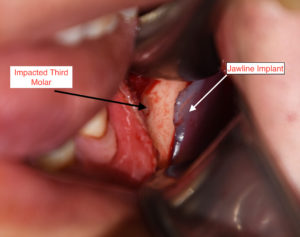Jaw angle implants as well as complete jawline implants are highly effective methods for augmentation of the lower third of the face. They either enhance the effects of a prior or concomitant chin augmentation or create an entire enhancement of the whole lower face as a stand alone implant procedure due to complete jawline bone coverage.
Whether it is paired jaw angle implants or a custom jawline implant, there is a need for intraoral incisions to place them. The intraoral incisions that both types of jaw implants share is the posterior jawline incision, which is a mucosal incision parallel to or just behind the second molar tooth in the depth of the soft tissue vestibule to its side. This incision provides access to perform the subperiosteal pocket dissection over the ramus (jaw angle) and forward to connect to the chin if needed.
Because of the need to pass the implant all the way through the mouth to get the incision and the exposure of the healing incision to the chewing of foods by the molar teeth, the risk of infection in these types of jawline implants is not rare. In fact in my experience it is the highest amongst all facial implants. (in the 2% to 4% range per implant)

Because of the risk of infection it would be prudent for all jaw angle and jawline implant patients to have their wisdom teeth removed prior to the implant surgery. At the least a partially erupted wisdom tooth should be removed prior to the implant surgery. Ideally even fully impacted wisdom teeth should be removed to prevent the remote risk in the future of possibly infecting the implant.
Dr. Barry Eppley
Indianapolis, Indiana


